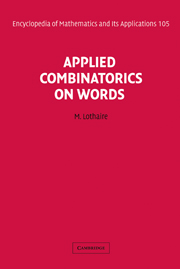Book contents
- Frontmatter
- Contents
- Preface
- Chapter 1 Algorithms on Words
- Chapter 2 Structures for Indexes
- Chapter 3 Symbolic Natural Language Processing
- Chapter 4 Statistical Natural Language Processing
- Chapter 5 Inference of Network Expressions
- Chapter 6 Statistics on Words with Applications to Biological Sequences
- Chapter 7 Analytic Approach to Pattern Matching
- Chapter 8 Periodic Structures in Words
- Chapter 9 Counting, Coding, and Sampling with Words
- Chapter 10 Words in Number Theory
- References
- General Index
Chapter 6 - Statistics on Words with Applications to Biological Sequences
Published online by Cambridge University Press: 05 June 2013
- Frontmatter
- Contents
- Preface
- Chapter 1 Algorithms on Words
- Chapter 2 Structures for Indexes
- Chapter 3 Symbolic Natural Language Processing
- Chapter 4 Statistical Natural Language Processing
- Chapter 5 Inference of Network Expressions
- Chapter 6 Statistics on Words with Applications to Biological Sequences
- Chapter 7 Analytic Approach to Pattern Matching
- Chapter 8 Periodic Structures in Words
- Chapter 9 Counting, Coding, and Sampling with Words
- Chapter 10 Words in Number Theory
- References
- General Index
Summary
Introduction
Statistical and probabilistic properties of words in sequences have been of considerable interest in many fields, such as coding theory and reliability theory, and most recently in the analysis of biological sequences. The latter will serve as the key example in this chapter. We only consider finite words.
Two main aspects of word occurrences in biological sequences are: where do they occur and how many times do they occurfi An important problem, for instance, was to determine the statistical significance of a word frequency in a DNA sequence. The naive idea is the following: a word may be significantly rare in a DNA sequence because it disrupts replication or gene expression, (perhaps a negative selection factor), whereas a significantly frequent word may have a fundamental activity with regard to genome stability. Well-known examples of words with exceptional frequencies in DNA sequences are certain biological palindromes corresponding to restriction sites avoided, for instance in E. coli, and the Cross-over Hotspot Instigator sites in several bacteria. Identifying over- and underrepresented words in a particular genome is a very common task in genome analysis.
Statistical methods of studying the distribution of the word locations along a sequence and word frequencies have also been an active field of research; the goal of this chapter is to provide an overview of the state of this research.
- Type
- Chapter
- Information
- Applied Combinatorics on Words , pp. 268 - 352Publisher: Cambridge University PressPrint publication year: 2005
- 3
- Cited by



